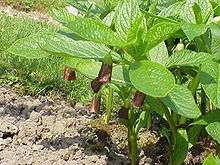Scopolia
| Scopolia | |
|---|---|
 | |
| Scopolia carniolica | |
| Scientific classification | |
| Kingdom: | Plantae |
| (unranked): | Angiosperms |
| (unranked): | Eudicots |
| (unranked): | Asterids |
| Order: | Solanales |
| Family: | Solanaceae |
| Genus: | Scopolia Lam. |
| Species | |
|
Scopolia carniolica | |
Scopolia is a genus of five species of flowering plants in the family Solanaceae, native to Europe and Asia. The genus is named after Giovanni Scopoli (1723–88), a Tyrolean naturalist.
Scopolia carniolica is a creeping perennial plant, with light green leaves and pale yellow to dull red flowers. It is sometimes cultivated as a decorative plant. Scopolia's extract (which contains a form of the alkaloid scopolamine) is used in at least one commercial stomach remedy (Inosea, produced by Sato Pharmaceutical). The extract is an anti-spasmodic in low doses and may be used to relax smooth muscle tissue or prevent motion-sickness induced nausea; in higher doses it is a poison having hallucinogenic and memory-inhibiting effects.
Other alkaloids found in Scopolia carniolica include cuscohygrine and hyoscyamine.
Alkaloids found in Scopolia tangutica include hyoscyamine, scopolamine, anisodamine, and anisodine.
Alkaloids found in Scopolia atropoides (possibly just a synonym for Scopolia carniolica) include atroscine.

The coumarin phenylpropanoids umbelliferone and scopoletin have been isolated from the roots of Scopolia japonica.
The related species Atropanthe sinensis is sometimes included in Scopolia as Scopolia sinensis.[1]
References
Further reading
- Ben-Wyk, Erik & Wink, Michael (2004). Medicinal Plants of the World. Timber Press. ISBN 0-88192-602-7.
- Huang, Kee Chang & Williams, Walter (1999). The pharmacology of Chinese herbs. CRC Press. ISBN 0-8493-1665-0.
- D'Arcy, William G. (1986). Solanaceae. Columbia University Press. ISBN 0-231-05780-6.